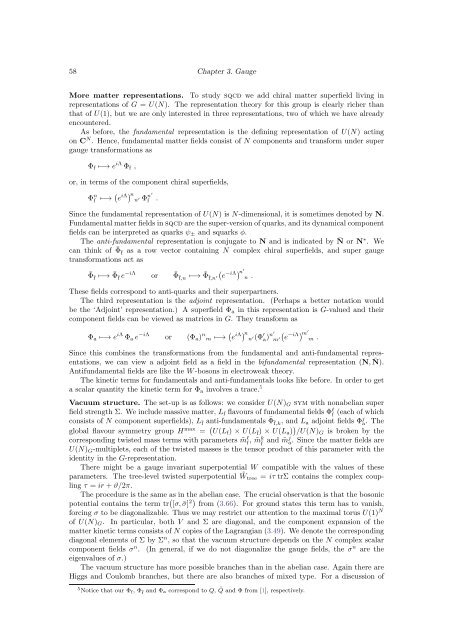The Bethe/Gauge Correspondence
The Bethe/Gauge Correspondence
The Bethe/Gauge Correspondence
You also want an ePaper? Increase the reach of your titles
YUMPU automatically turns print PDFs into web optimized ePapers that Google loves.
58 Chapter 3. <strong>Gauge</strong>More matter representations. To study sqcd we add chiral matter superfield living inrepresentations of G = U(N). <strong>The</strong> representation theory for this group is clearly richer thanthat of U(1), but we are only interested in three representations, two of which we have alreadyencountered.As before, the fundamental representation is the defining representation of U(N) actingon C N . Hence, fundamental matter fields consist of N components and transform under supergauge transformations asΦ f ↦−→ e iΛ Φ f ,or, in terms of the component chiral superfields,Φ n f↦−→ ( e iΛ) nn ′ Φn′ f .Since the fundamental representation of U(N) is N-dimensional, it is sometimes denoted by N.Fundamental matter fields in sqcd are the super-version of quarks, and its dynamical componentfields can be interpreted as quarks ψ ± and squarks φ.<strong>The</strong> anti-fundamental representation is conjugate to N and is indicated by ¯N or N ∗ . Wecan think of ¯Φ¯f as a row vector containing N complex chiral superfields, and super gaugetransformations act as¯Φ¯f ↦−→ ¯Φ¯f e −iΛ or ¯Φ¯f,n ↦−→ ¯Φ¯f,n ′(e−iΛ ) n ′ n .<strong>The</strong>se fields correspond to anti-quarks and their superpartners.<strong>The</strong> third representation is the adjoint representation. (Perhaps a better notation wouldbe the ‘Adjoint’ representation.) A superfield Φ a in this representation is G-valued and theircomponent fields can be viewed as matrices in G. <strong>The</strong>y transform asΦ a ↦−→ e iΛ Φ a e −iΛ or (Φ a ) n m ↦−→ ( e iΛ) nn ′(Φ′ a) n′ m ′ (e−iΛ ) m ′ m .Since this combines the transformations from the fundamental and anti-fundamental representations,we can view a adjoint field as a field in the bifundamental representation (N, ¯N).Antifundamental fields are like the W -bosons in electroweak theory.<strong>The</strong> kinetic terms for fundamentals and anti-fundamentals looks like before. In order to geta scalar quantity the kinetic term for Φ a involves a trace. 5Vacuum structure. <strong>The</strong> set-up is as follows: we consider U(N) G sym with nonabelian superfield strength Σ. We include massive matter, L f flavours of fundamental fields Φ l f(each of whichconsists of N component superfields), L¯f anti-fundamentals ¯Φ¯f,k , and L a adjoint fields Φ j a. <strong>The</strong>global flavour symmetry group H max = ( U(L f ) × U(L¯f) × U(L a ) ) /U(N) G is broken by thecorresponding twisted mass terms with parameters ˜m l f , ˜mk¯f and ˜m j a. Since the matter fields areU(N) G -multiplets, each of the twisted masses is the tensor product of this parameter with theidentity in the G-representation.<strong>The</strong>re might be a gauge invariant superpotential W compatible with the values of theseparameters. <strong>The</strong> tree-level twisted superpotential ˜Wtree = iτ trΣ contains the complex couplingτ = ir + ϑ/2π.<strong>The</strong> procedure is the same as in the abelian case. <strong>The</strong> crucial observation is that the bosonicpotential contains the term tr ( [σ, ¯σ] 2) from (3.66). For ground states this term has to vanish,forcing σ to be diagonalizable. Thus we may restrict our attention to the maximal torus U(1) Nof U(N) G . In particular, both V and Σ are diagonal, and the component expansion of thematter kinetic terms consists of N copies of the Lagrangian (3.49). We denote the correspondingdiagonal elements of Σ by Σ n , so that the vacuum structure depends on the N complex scalarcomponent fields σ n . (In general, if we do not diagonalize the gauge fields, the σ n are theeigenvalues of σ.)<strong>The</strong> vacuum structure has more possible branches than in the abelian case. Again there areHiggs and Coulomb branches, but there are also branches of mixed type. For a discussion of5 Notice that our Φ f , Φ¯f and Φ a correspond to Q, ˜Q and Φ from [1], respectively.
















